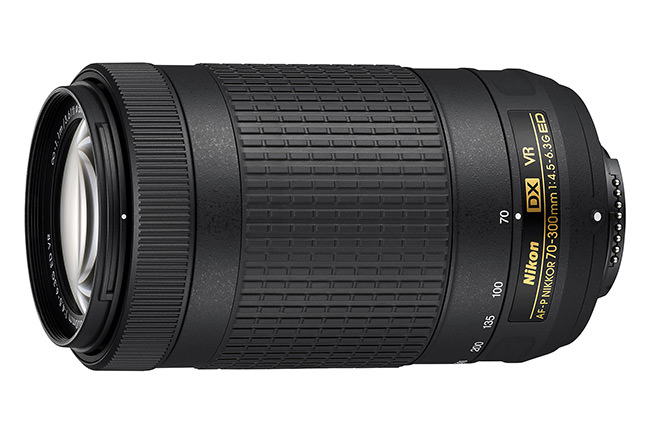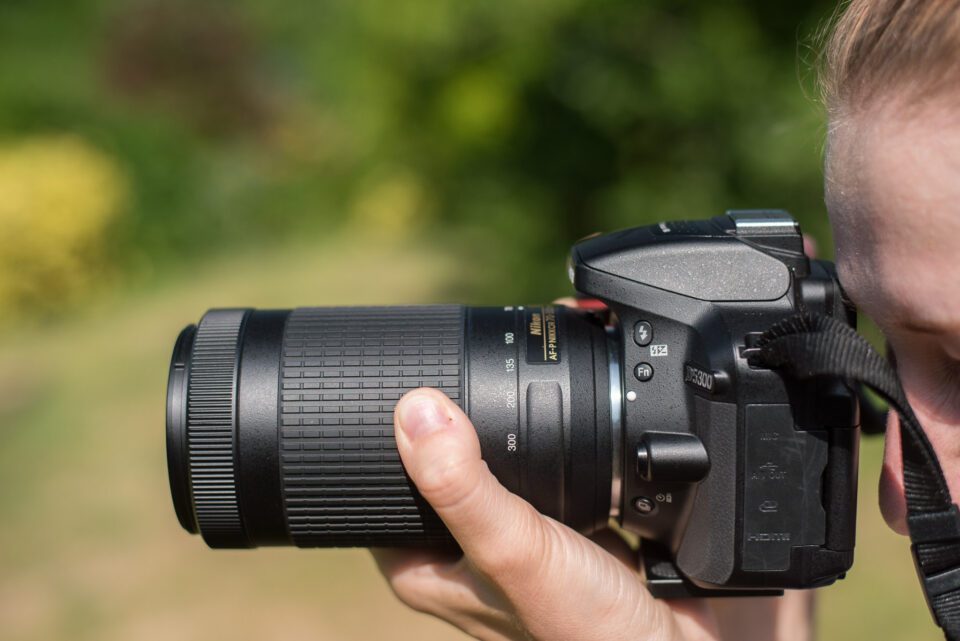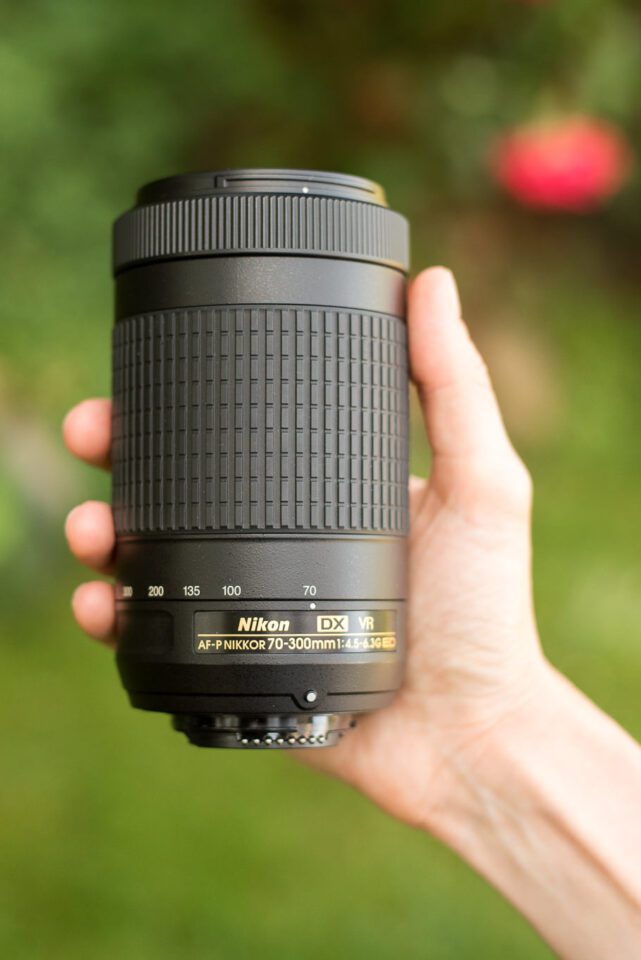Nikon Af-p Dx Nikkor 70–300mm F/45–63g Ed Vr Lens Review
In this in-depth field review, nosotros are going to have a look at a Nikon telephoto zoom DX lens, the Nikon AF-P DX NIKKOR lxx-300mm f/4.5-vi.3G ED VR, which was launched in August of 2016. This is one of the iii existing DX lenses featuring the new AF-P abbreviation, along with the Nikkor 18-55mm (VR and non-VR versions) and the new Nikkor 10-20mm VR broad-angle lens. AF-P stands for a new piece of applied science – a pulsing / stepping focusing motor.

This production hardly caused any excitement, as it is an all-plastic lens designed primarily for entry-level DSLRs. Nikkor 70-300mm DX VR AF-P lens is currently sold in many popular sets with DSLR bodies such as D5600, D3400 and D7200. In the past, kit lenses were notorious for their low build quality and rather mediocre optical performance. Nikon, however, managed to produce quite a few decent basic DX zoom lenses (such equally the 55-300mm DX VR and 18-55 DX VR) that yield very proficient performance / cost ratio. While many enthusiast photographers call for dedicated DX primes, Nikon decided to invest its resources into even more than lightweight and compact DX zooms, such as the new 70-300mm DX VR AF-P lens. How does this lens with new pattern fare in a real-life test? Let's have a look.

Compatibility
Important notice: the AF-P line is only compatible with the latest Nikon DSLR bodies. It means the number of cameras usable with the lens is limited.
This is how Nikon U.s. specifies compatibility by group cameras in iii subsets:
- Fully compatible models: Fifty-fifty for compatible cameras, firmware update may be required. Fully compatible models are: D7500, D5600, D5500, D5300, D3400, D3300, D500 and afterward models
- Compatible models with limited functions: D5, D810 serial, Df, D750, D7200, D7100, D5200, Nikon 1 series with the FT1
- Incompatible models: D4 series, D3 serial, D2 series, D1 series, D800 series, D700, D610, D600, D300 serial, D200, D100, D7000, D5100, D5000, D90, D80, D70 series, D3200, D3100, D3000, D60, D50, D40 series, flick cameras
I have tested this lens on my old Nikon DSLR D7000 (featured by Nikon as an incompatible model) and it indeed does not piece of work. Since the focusing is fully electronic, you cannot fifty-fifty utilize the transmission focusing. The pic in the viewfinder stays blurred all the fourth dimension, no affair how you turn the focus band. Stay away from this lens if yous have an old torso and program to stick with it.

To find out more about the lens, please check out the Nikon AF-P DX NIKKOR 70-300mm f/4.5-half dozen.3G ED VR page of our lens database.
Lens Treatment and Features
The Nikon 70-300mm VR AF-P is a lightweight, small, and ultra-portable tele-zoom lens, which feels not bad in your hands and balances well with all crop sensor DSLRs (DX format). The VR version weights every bit picayune as 415 grams (14.7 oz), the not-VR version is slightly lighter (past some 10g). Such low weight is due to its all-plastic design, including a plastic mount. I personally accept no effect with plastic mounts, Nikon started using them even in some college priced lenses:

The lens has a total of 14 elements in 10 groups with one actress-depression dispersion element. There is no aspherical element.
The 4.3x zoom of this 70-300mm lens is a nice range, offer far reach on DX bodies (roughly equivalent to 450mm in field of view on a full-frame camera). The direct DX predecessor of this lens offered even a wider range by having 55mm on the brusk end, which I would personally prefer, but I understand that such a structure calls for more optical compromises that negatively touch on the image quality.


The zoom ring is very large, occupying virtually of the lens barrel, which makes it easy to zoom in and out with your left mitt, while holding the camera with your right hand. The ring is perfectly damped with just the right amount of resistance and zoom pitter-patter is not an effect.
At the front, a relatively sparse focus ring is placed – notwithstanding it due to a very compact size, the band placement at the very front end still keeps the performance very easy.
Nikon'due south "P" series of NIKKOR lenses use stepping motors to "focus smoother and quieter than previous drive systems. This quiet drive system makes the lenses ideal for apply when shooting video." (quotation from Nikon Printing-release). See section iv where I write how the lens fares in real-life shooting.
Strikingly, the AF-P line of lenses, including this 70-300mm tele-zoom, has no mechanical switches (VR or AF/MF). The absence of AF/MF switch is not a big deal, since the lens features a abiding manual override choice, which comes equally a new feature. On older DX kit lenses, you lot had to first switch to "G mode on the lens to be able to rotate the forepart of the lens barrel, where the focus ring is located. This lens allows you to override autofocus by merely rotating the focus ring – whatsoever fourth dimension. I notice this very handy and practical.

The VR switch absence is more than puzzling though, every bit you must go into your camera internal set-up carte to switch VR functionality on or off. What'due south more than, not all compatible cameras accept this feature (such as my D7100). Encounter more information in section five.
This lens can be paired with a B-77 bayonet lens hood, but information technology is not included in the price (unlike with the previous version of 55-300mm). You must purchase information technology separately for xxx USD.
Since information technology is a variable aperture lens, the focal length on it changes as you zoom in from f/iv.v to f/6.iii on the long end:
- 70mm – f/iv.5
- 72mm – f/iv.viii
- 150mm – f/5
- 180mm – f/five.3
- 240mm – f/6
- 270mm – f/6.3
- 300mm – f/6.3
Compared to the previous Nikon 55-300mm DX VR, and the even the older 70-300mm VR, this new DX AF-P version offers a slower aperture at 300mm – f/half dozen.3 instead of the more usual f/5.6. While at offset information technology may seem as a big change, it is really simply 1/3 EV slower, which to me is adequate if focusing and optical functioning are OK. And so how are they?

Source: https://photographylife.com/reviews/nikon-70-300mm-dx-vr-af-p